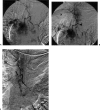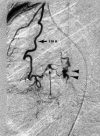Bronchial artery embolization for treatment of life-threatening hemoptysis
- PMID: 21326768
- PMCID: PMC3036375
- DOI: 10.1055/s-2006-948759
Bronchial artery embolization for treatment of life-threatening hemoptysis
Abstract
Massive hemoptysis is an emergent and life-threatening condition with a broad range of underlying causes. Fortunately, massive hemoptysis accounts for a minority of cases of hemoptysis, ~5%. Unlike hemorrhage in other areas of the body, the primary cause of death from pulmonary hemorrhage is most commonly asphyxiation rather than exsanguination. Given the limited capacity for the lung to preserve oxygen transfer in the setting of massive hemoptysis, a rapid and effective method for controlling hemorrhage is essential to minimize death in patients demonstrating respiratory compromise. Since its introduction in 1973, bronchial artery embolization has proven to be a safe and effective tool for the treatment of massive hemoptysis and is now considered the treatment of choice, with initial success rates ranging from 77 to 94%. The long-term control rate of hemoptysis ranges from 70 to 85% and is largely a function of the degree of inflammation and the natural progression of the underlying disease. This article reviews the current literature on bronchial artery embolization for the treatment of massive hemoptysis.
Keywords: Hemoptysis; bronchial artery embolization; embolization; massive hemoptysis.
Figures






References
-
- In: Fraser RS, Muller NL, Colman N, Pare PD, editor. Diagnosis of Diseases of the Chest. Philadelphia: WB Saunders; 1999. The clinical history and physical examination. pp. 379–403.
-
- de Gregorio M A, Medrano J, Mainar A, et al. Endovascular treatment of massive hemoptysis by bronchial artery embolization: short-term and long-term follow-up over a 15-year period. Arch Bronconeumol. 2006;42:49–56. - PubMed
-
- Corr P D. Bronchial artery embolization for life-threatening hemoptysis using tris-acryl microspheres: short-term result. Cardiovasc Intervent Radiol. 2005;28:439–441. - PubMed
-
- Ustunsoz B, Bozlar U, Ors F, Gurkok S, Balkan A, Ilica T. Bronchial artery embolization: experience with 10 cases. Diagn Interv Radiol. 2006;12:43–46. - PubMed
-
- Yoon W, Kim J K, Kim Y H, Chung T W, Kang H K. Bronchial and nonbronchial systemic artery embolization for life-threatening hemoptysis: a comprehensive review. Radiographics. 2002;22:1395–1409. - PubMed

